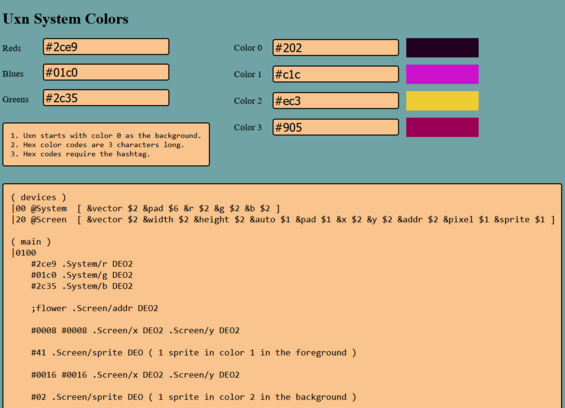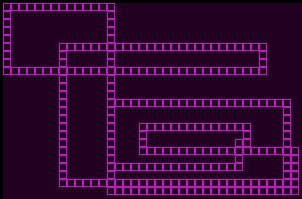Neurotrace :typescript: :rust: · @Neurotrace
3 followers · 39 posts · Server fosstodon.orgSo #uxn is pretty cool. Weekend plans include building a few tiny things in it then start designing a language that compiles to #uxntal just for fun.
I've only barely gotten in to it but I'm wondering if it's possible to get around the color limit with some tricky timing. I remember reading that you could display more colors on the NES by switching the palette between scanlines
Devine Lu Ator · @neauoire
10072 followers · 60454 posts · Server merveilles.townImplementing structural editing in #uxntal. I remember having lots of fun with THINK Pascal when the IDE was reformatting my program automatically and I've been meaning to have this as part of my workflow now.
Devine Lu Ator · @neauoire
9963 followers · 60032 posts · Server merveilles.townFor speed-critical loops in #uxntal, consider this pattern:
Use the return-stack to juggle the function pointer and if you can, flatten your boundaries to a single byte(so 0..0x10, becomes 0x0f).
Devine Lu Ator · @neauoire
9925 followers · 59882 posts · Server merveilles.town@wim_v12e aaah, then yes, nothing to worry about there then.
I'm not sure if you've seen @bellinitte's padding mod to #uxntal (https://merveilles.town/@bellinitte/110141437531968122) but you miiight be able to make use of this somehow.
Devine Lu Ator · @neauoire
9896 followers · 59719 posts · Server merveilles.townMade a little companion REPL to Left, select a bit of code and press ctrl+p to have it assembled and evaluated in the Bicycle window. It's a good way to learn how #uxntal translates to bytes, and vice-versa.
Devine Lu Ator · @neauoire
9889 followers · 59688 posts · Server merveilles.townUnderstanding enums in #uxntal. Or, the recurring "why is the device page overlapping the zero-page" question.
Devine Lu Ator · @neauoire
9889 followers · 59658 posts · Server merveilles.townAdded a few notes to the #uxntal page on how to quote/unquote opcodes and functions. "Quoting" here means to defer an operation, as in in, evaluating it later. It's doubles as a little introduction to Uxn's self-modification patterns.
http://wiki.xxiivv.com/site/uxntal_immediate.html
:uxn:
R. L. Dane · @RL_Dane
1201 followers · 17845 posts · Server fosstodon.orgLearning to adapt my workflow to the BSDs has given me some of this fun feeling back, and also playing with #uxn, the not-quite-retro #permacomputing 16-bit virtual machine and assembler.
I stayed up until 6am configuring #OpenBSD on my old #stinkpad a couple nights in a row a few months ago 😅
#BSD gives me the feeling of using old Sun workstations 30 years ago (but modern).
uxn gives me the feeling of late 8-bit and early 16-bit home micros.
#uxn #permacomputing #openbsd #stinkpad #bsd #freebsd #netbsd #runbsd #uxntal
DHeadshot's Alt · @ddlyh
26 followers · 1578 posts · Server topspicy.socialDHeadshot's Alt · @ddlyh
24 followers · 1337 posts · Server topspicy.socialMade a #NotepadPlusPlus language configuration file for #uxntal to make programming it easier: https://pastebin.com/hWyw6pMp
#uxn
WimⓂ️ · @wim_v12e
245 followers · 963 posts · Server merveilles.townWimⓂ️ · @wim_v12e
241 followers · 953 posts · Server merveilles.townPotassium · @potassium
11 followers · 37 posts · Server mindly.socialLearned how the #uxn color palette works and then modified hex values in the writing app 'Left' to display in dark mode! This is fun! 😀
Potassium · @potassium
11 followers · 36 posts · Server mindly.socialDevine Lu Linvega · @neauoire
9204 followers · 57474 posts · Server merveilles.townEvery few months I rewrite the #uxntal assembler, and each time I find new and better ways to do certain things.
The whole assembler is now 1752 bytes, or 433 lines of #uxntal.
https://git.sr.ht/~rabbits/drifblim/tree/main/item/src/drifblim.tal
Hans X · @zephyrfalcon
33 followers · 89 posts · Server mastodon.socialI understand it correctly, the #uxn virtual machine is essentially separate from the #varvara computer. In the sense that you could write a _different_ computer/front-end for #uxn, that still uses #uxntal but may have different capabilities than Varvara, using different ports.
krowe · @krowemoh
3 followers · 217 posts · Server mastodon.socialI made a little utility to learn the system colors and it definitely helped.
https://nivethan.dev/toys/uxn-tools/system-colors.html
These little side projects are fun.
krowe · @krowemoh
3 followers · 213 posts · Server mastodon.socialDay 3 on #uxn. I think this day is much better as a first day. It might throw you into the deep end but I think I liked learning conditionals and jumps far more than bits and bytes. It did help that I already knew how stacks and ops worked.
yeti · @yeti
62 followers · 225 posts · Server emacs.chDevine Lu Linvega · @neauoire
9129 followers · 57331 posts · Server merveilles.townI've been working on implementing callable words in #uxntal.
Instead of the typical PUSH->POP->JSR sequence each time you want to run a routine, these tokens are not pushing to the stack - they'll run immediately.
They'll be impractical for doing pointer arithmetic, but save 1 byte for every subroutine call, and will save millions of cycles in a project of the size of a text editor or drawing software.
They don't break compatibility with old roms, and make source files a bit more readable.





